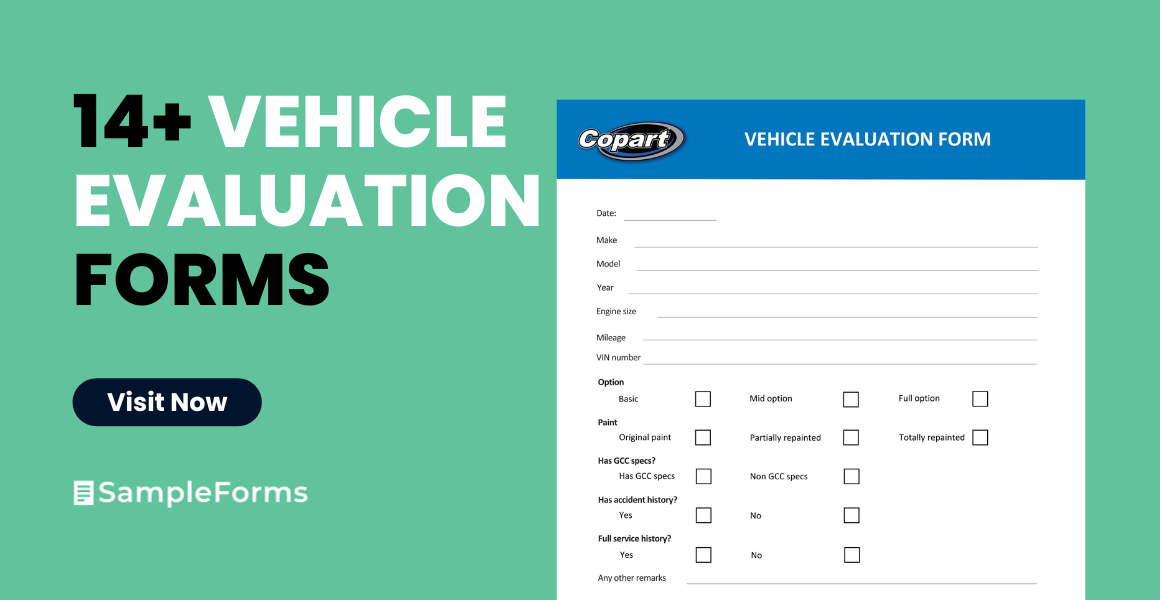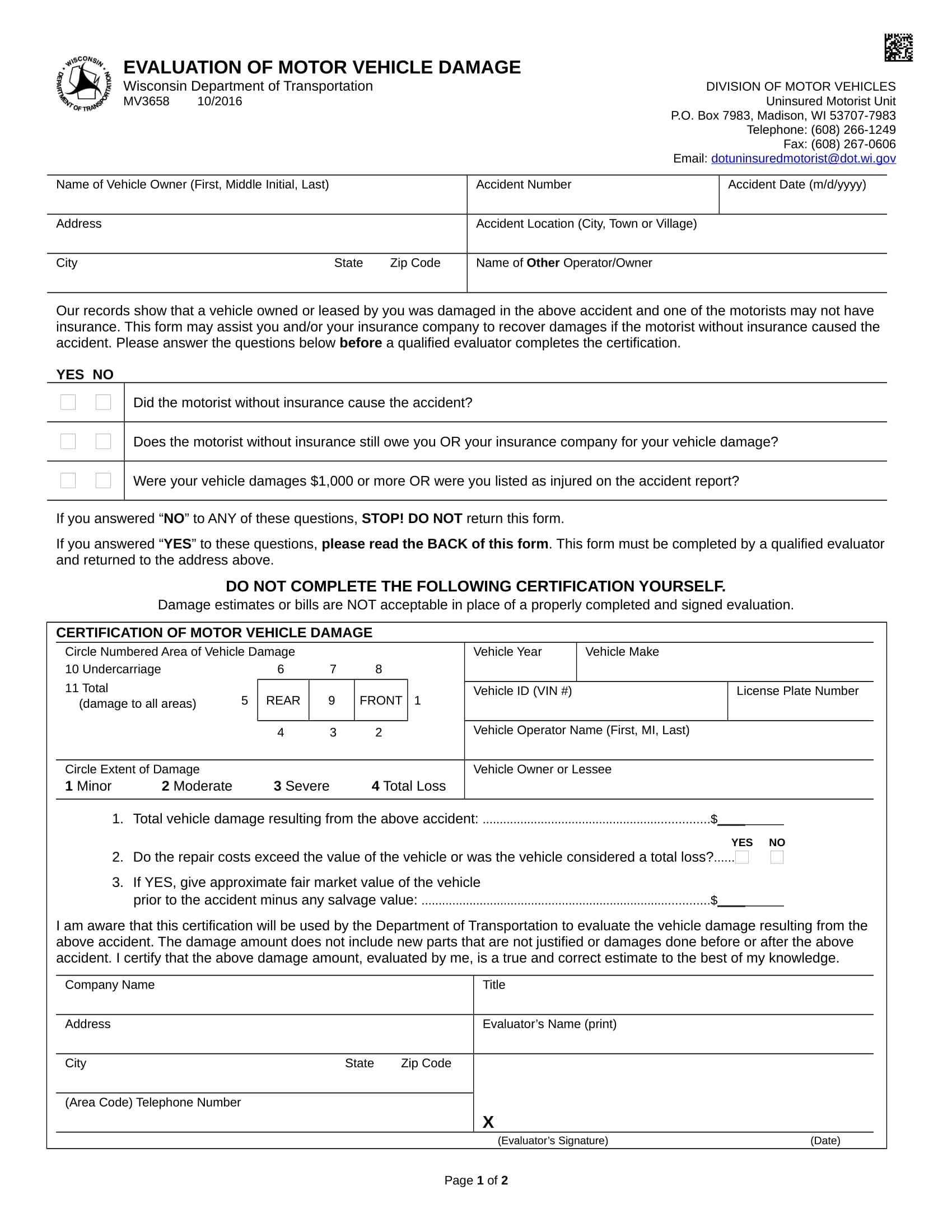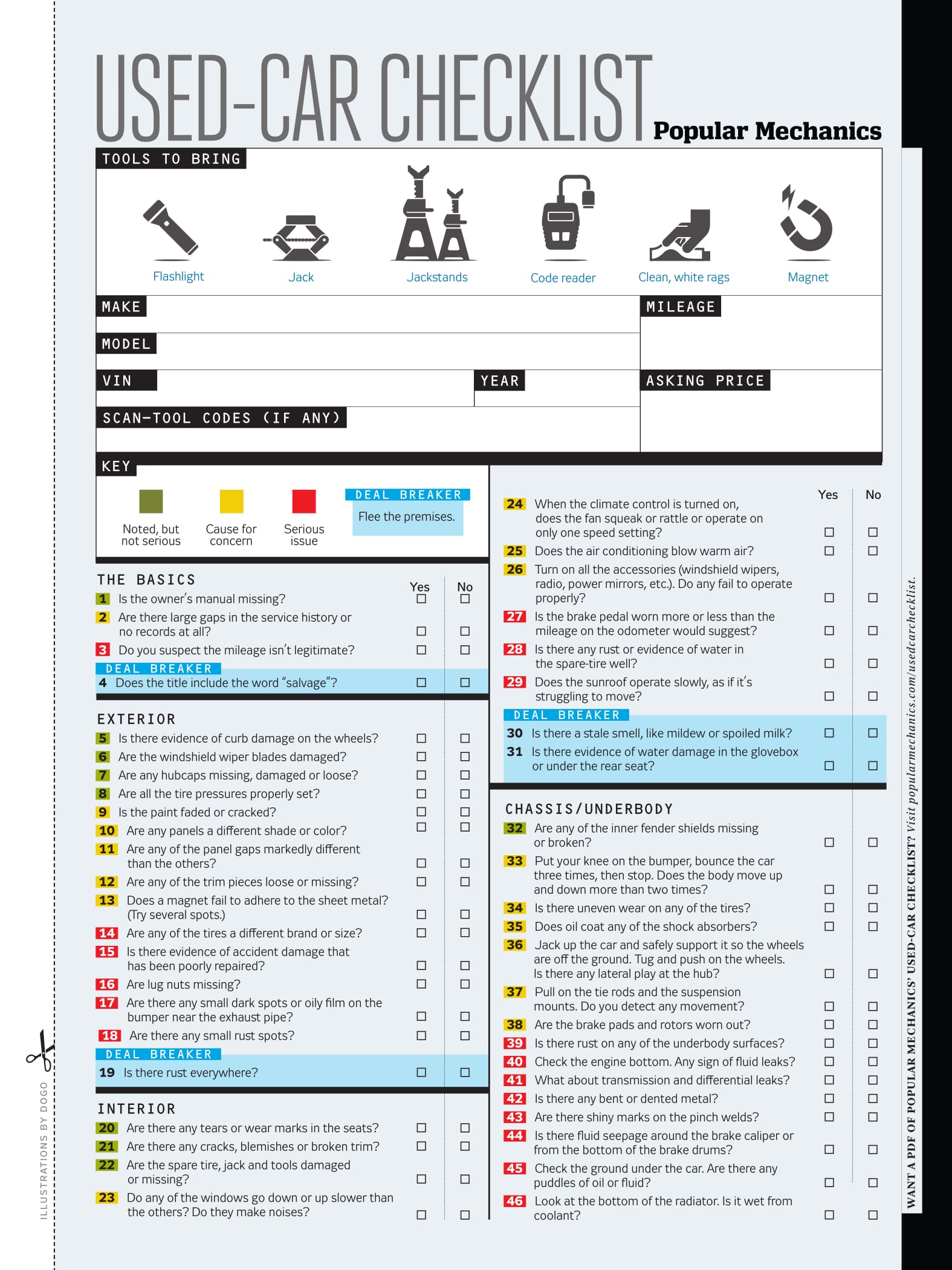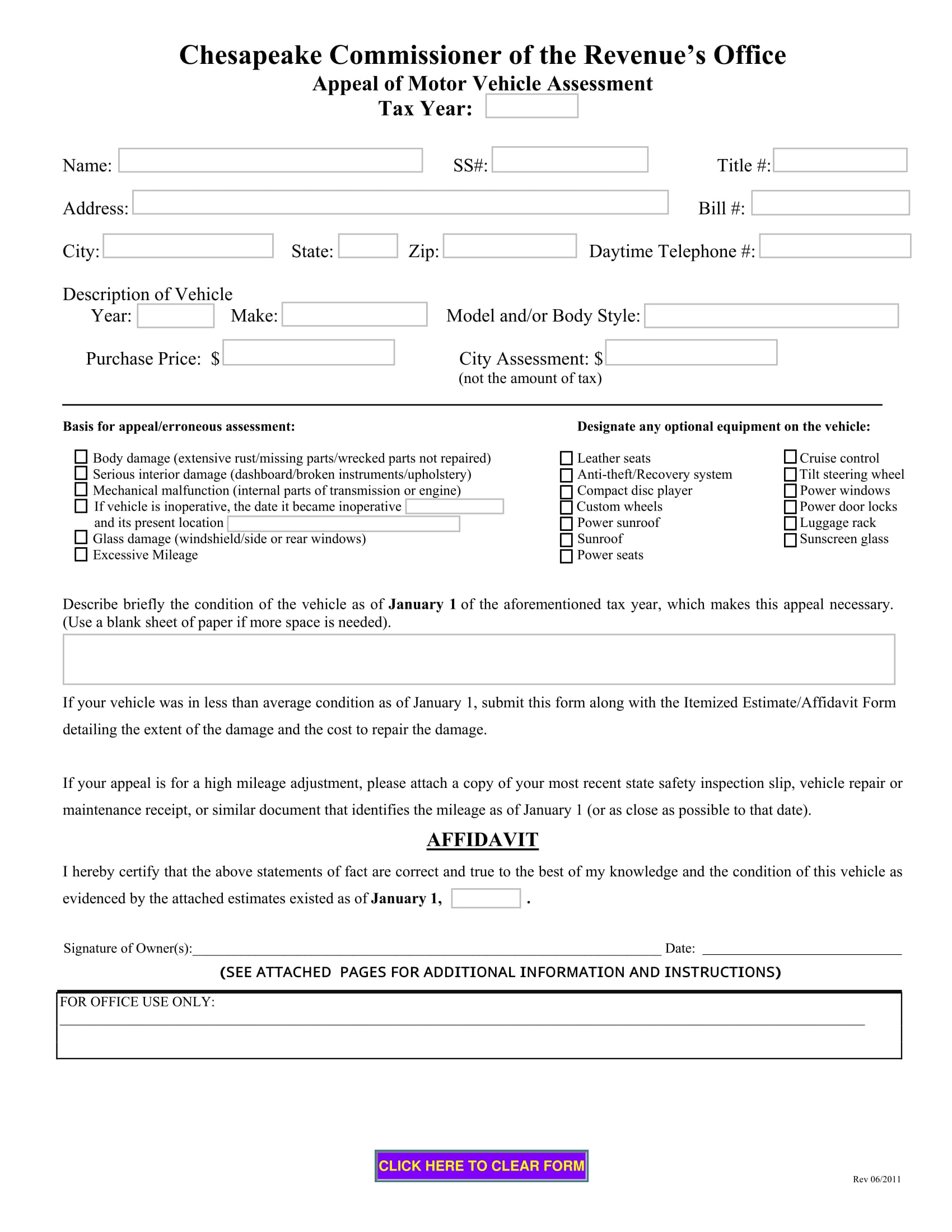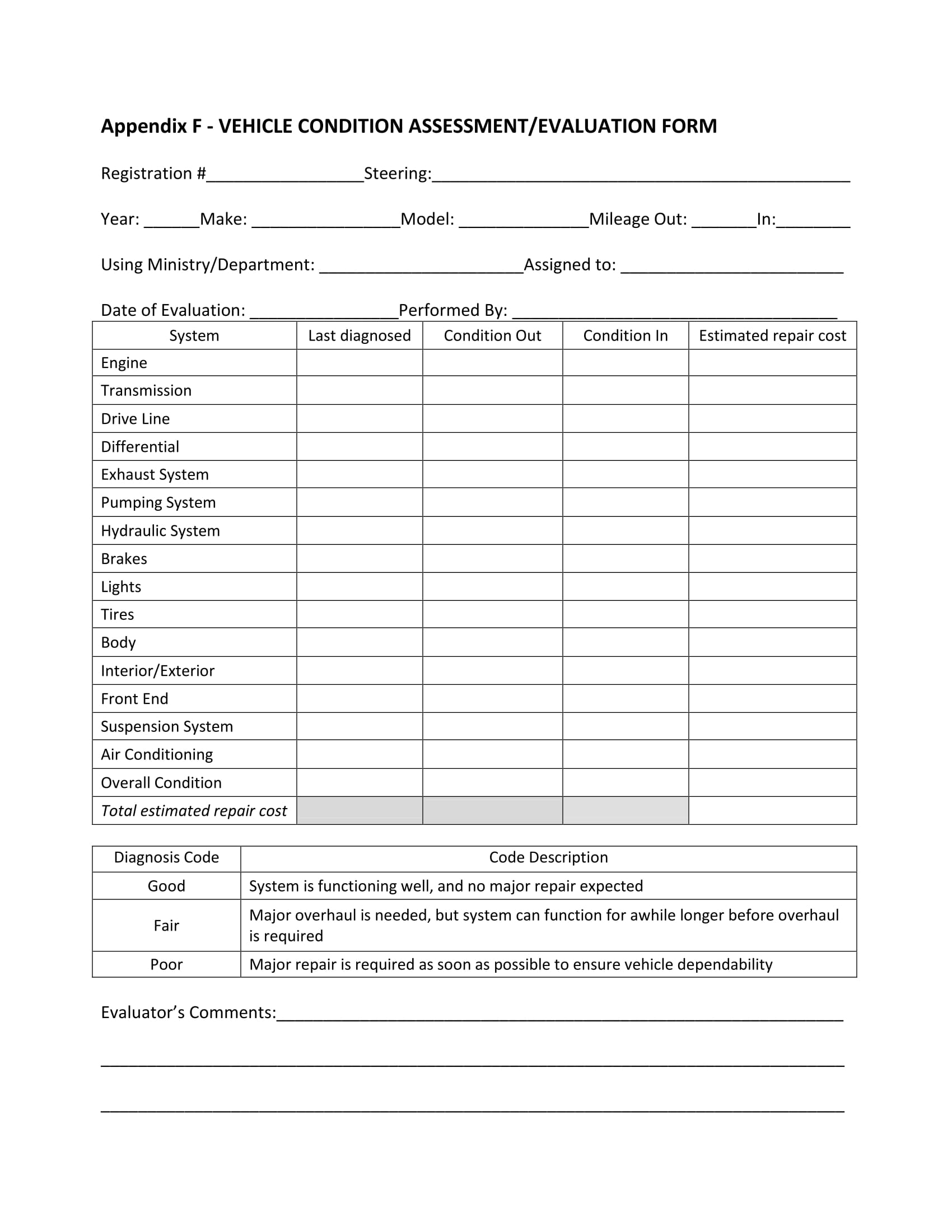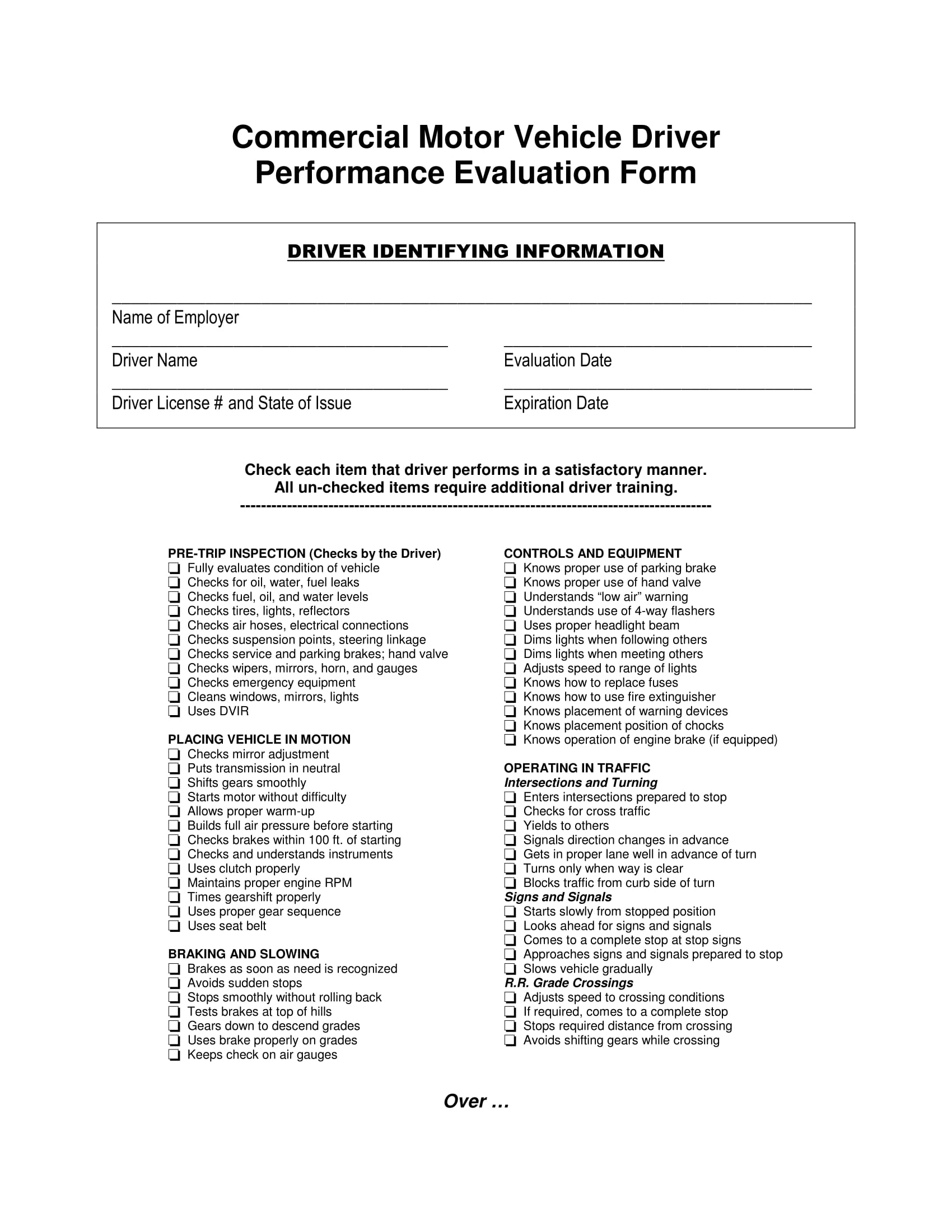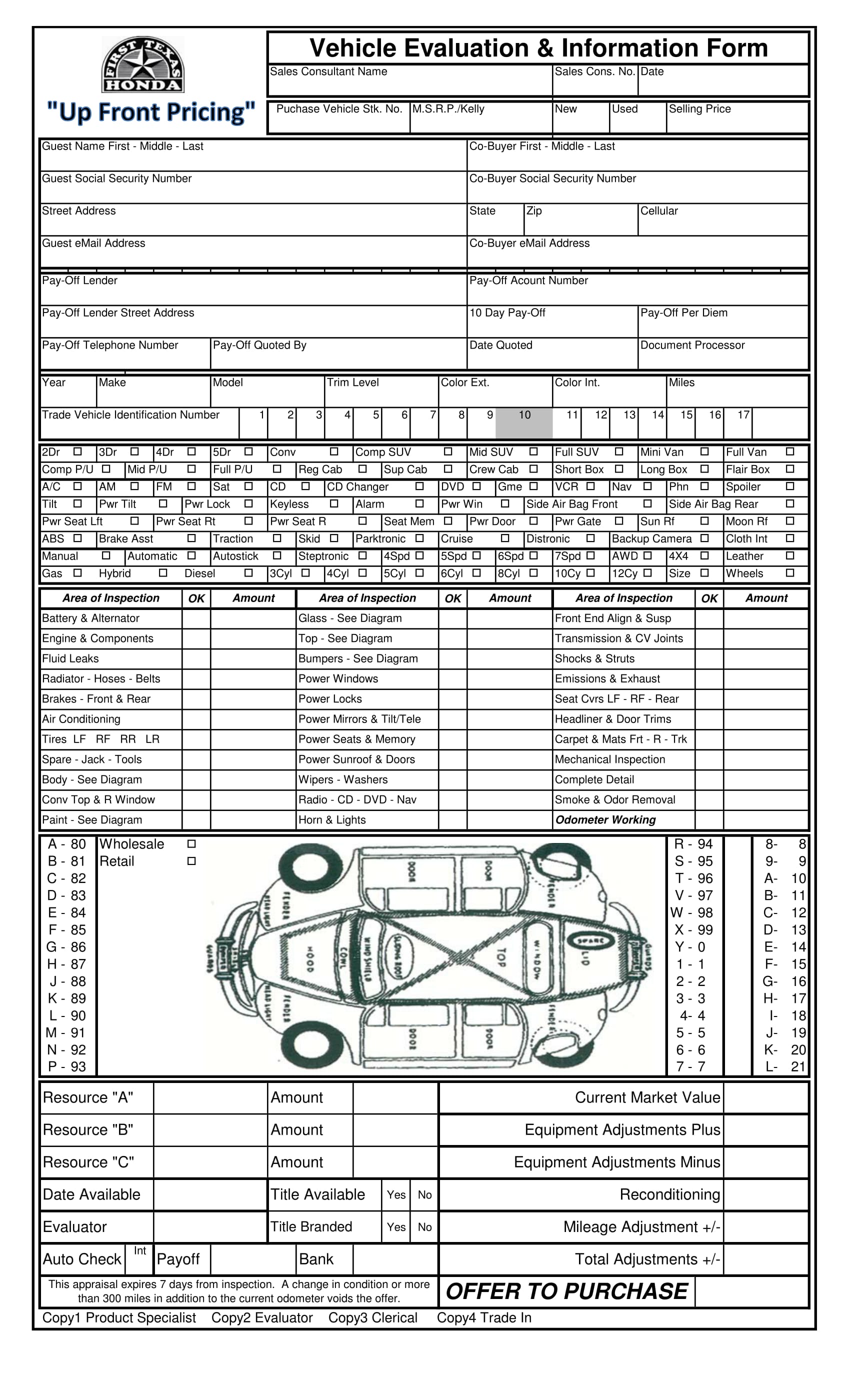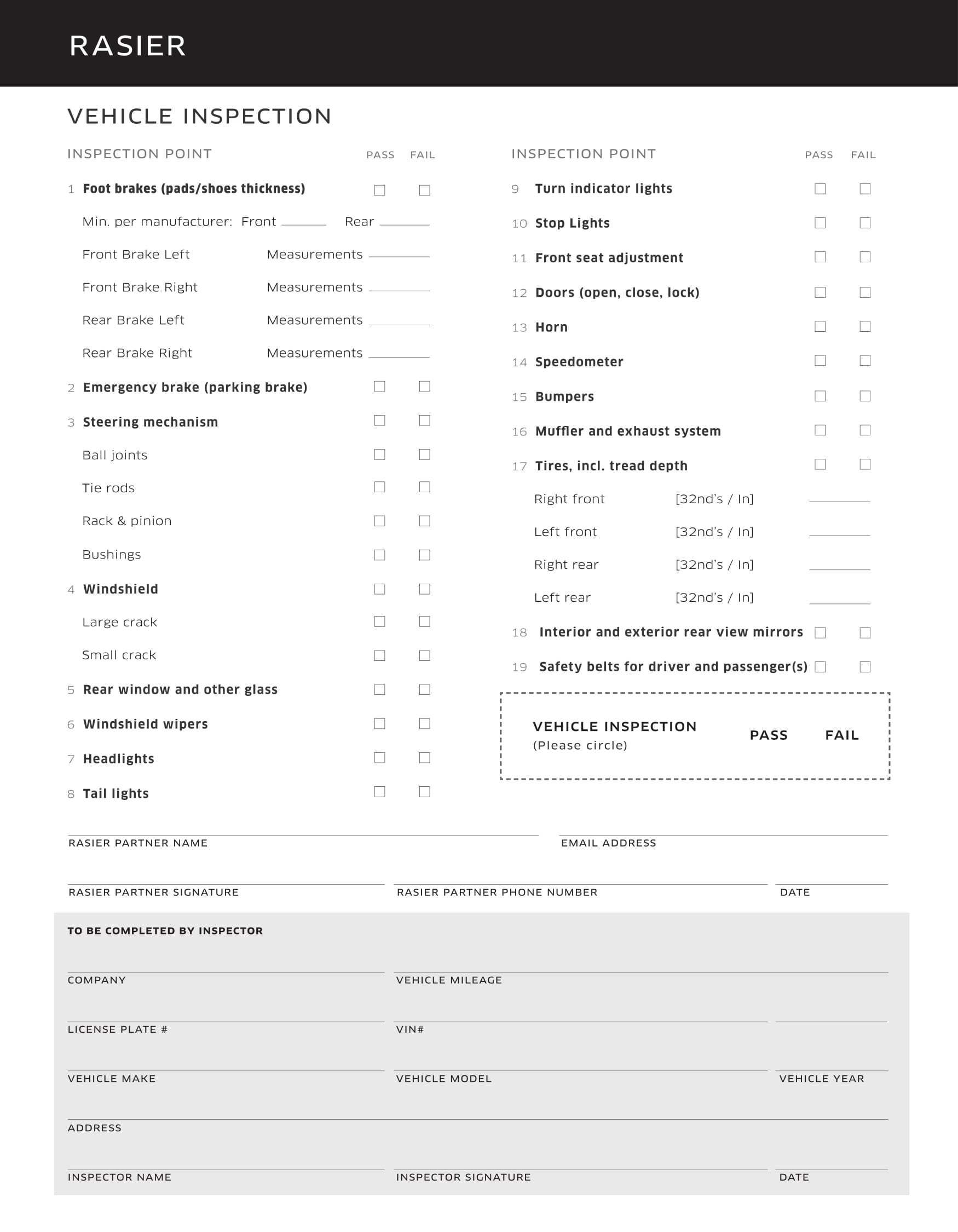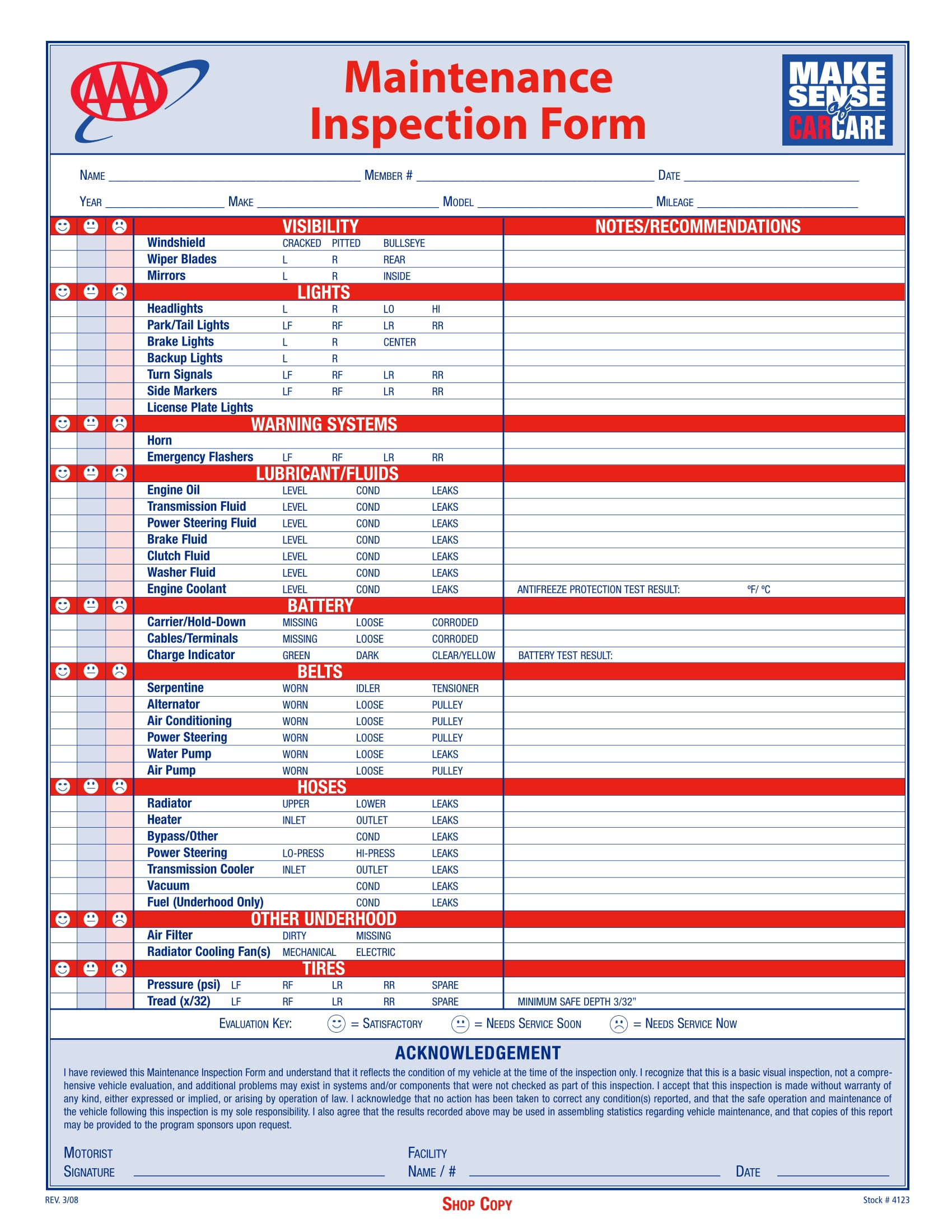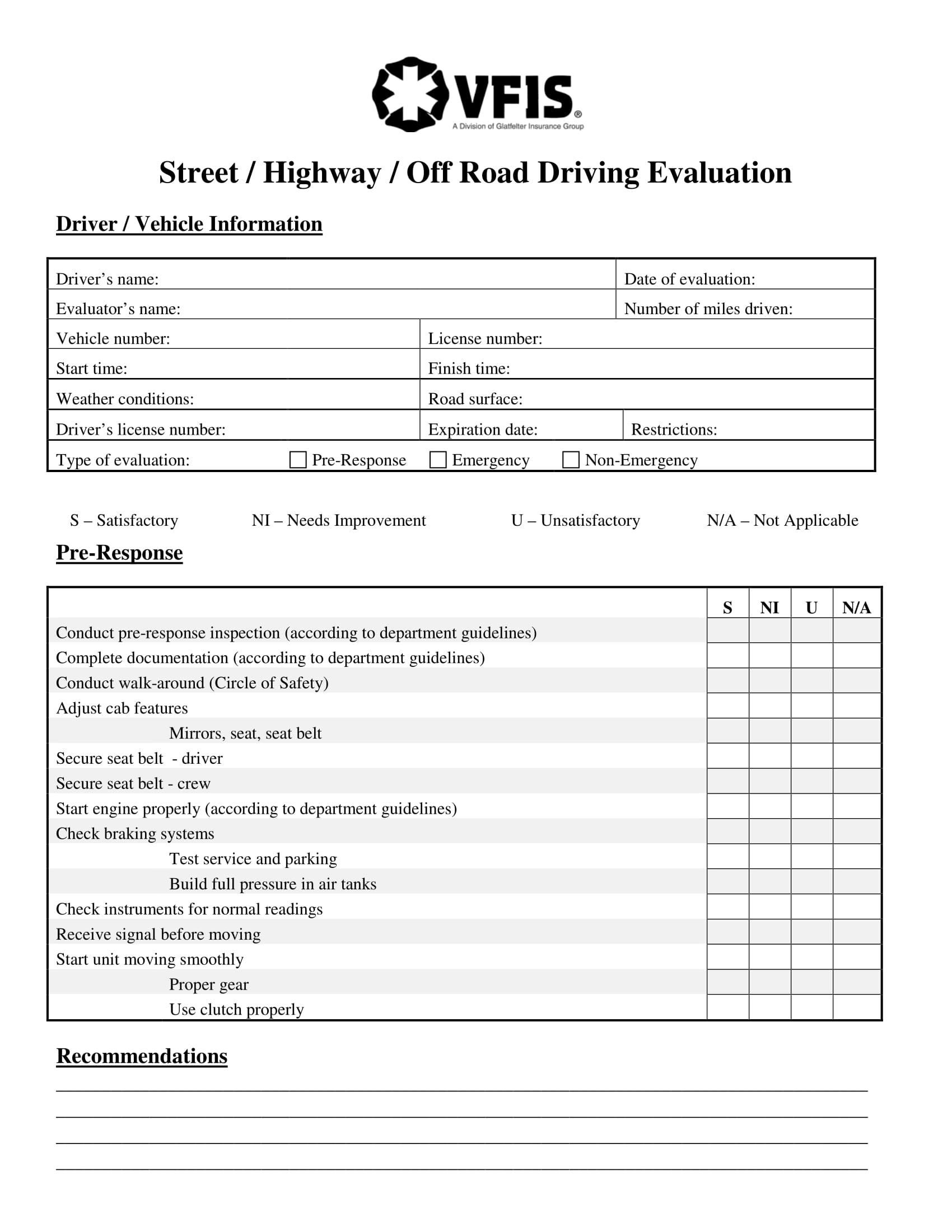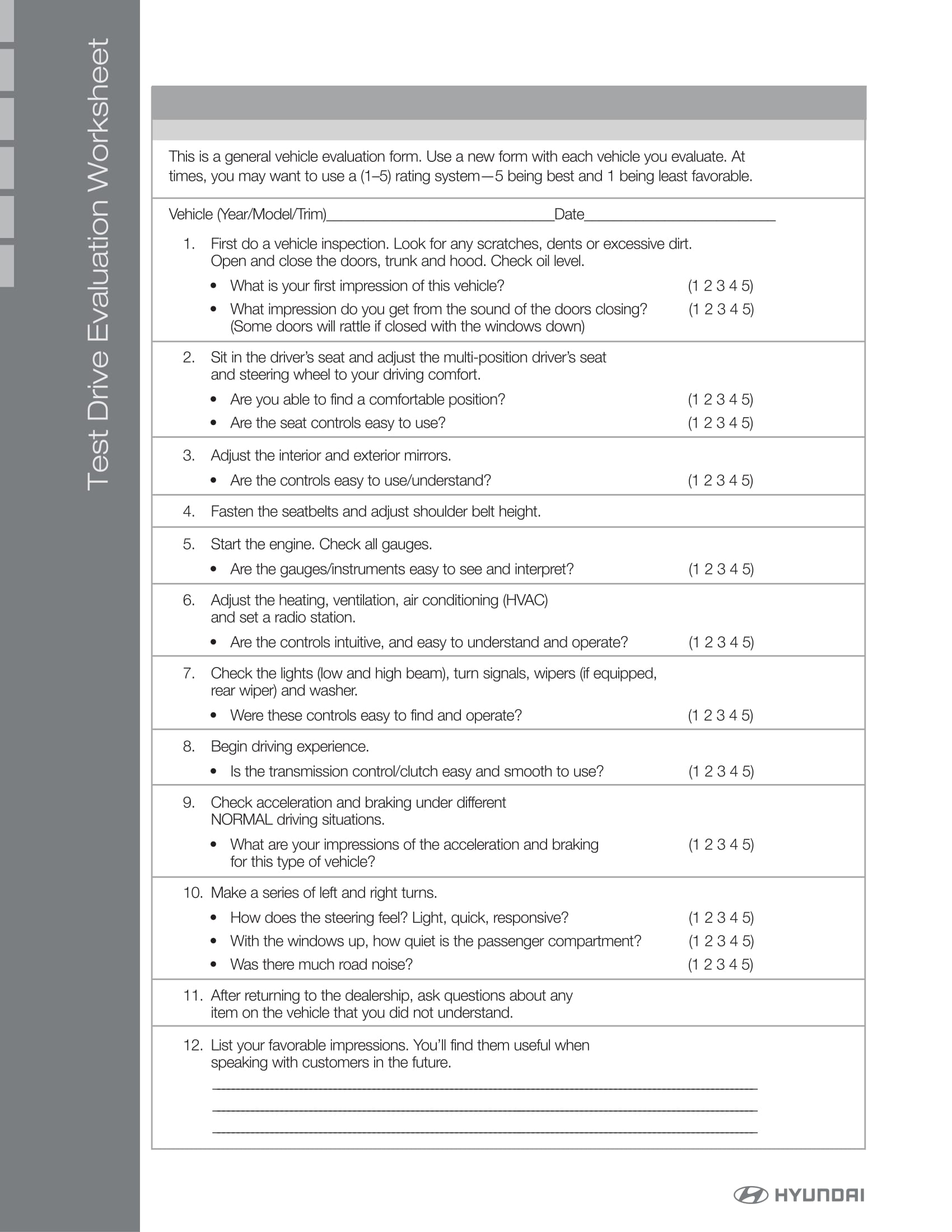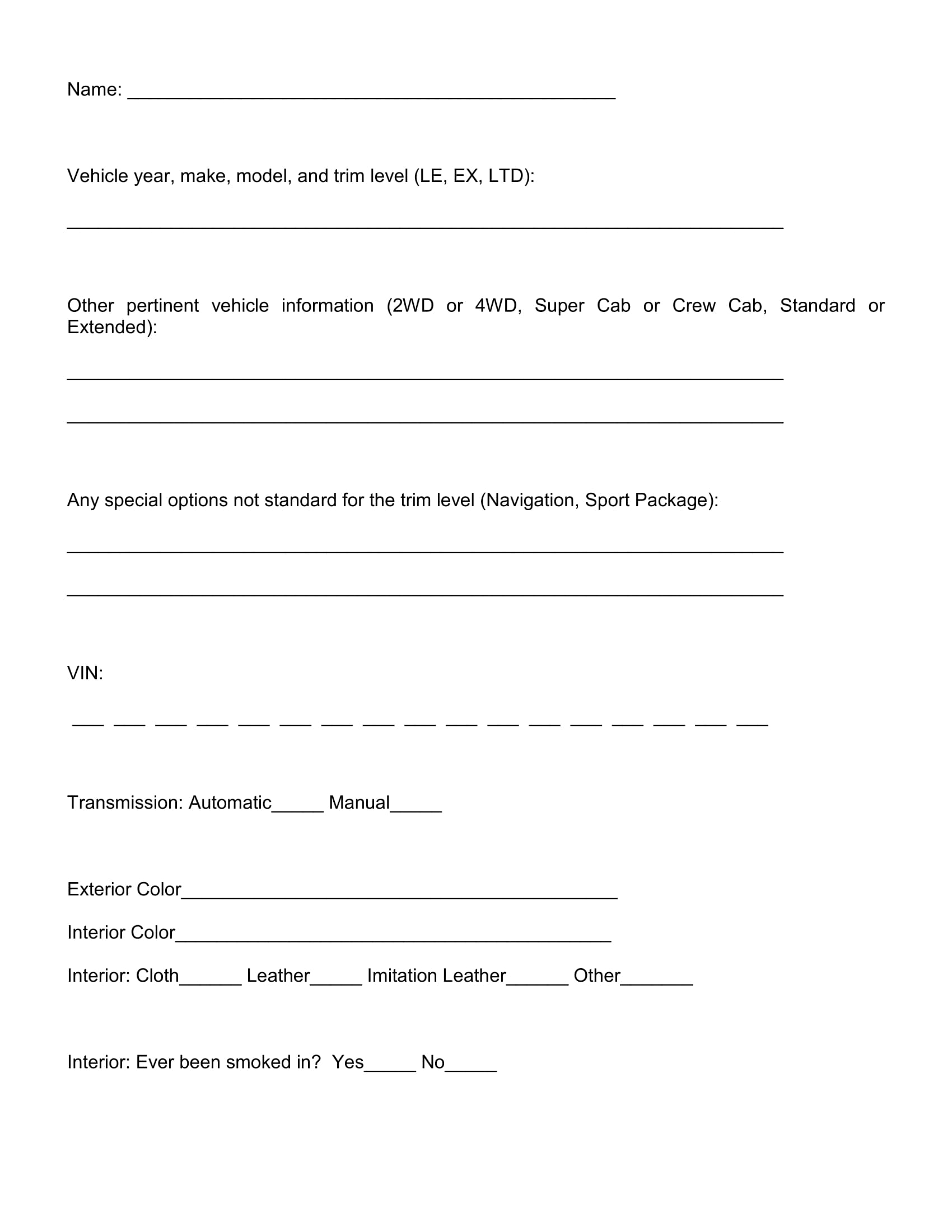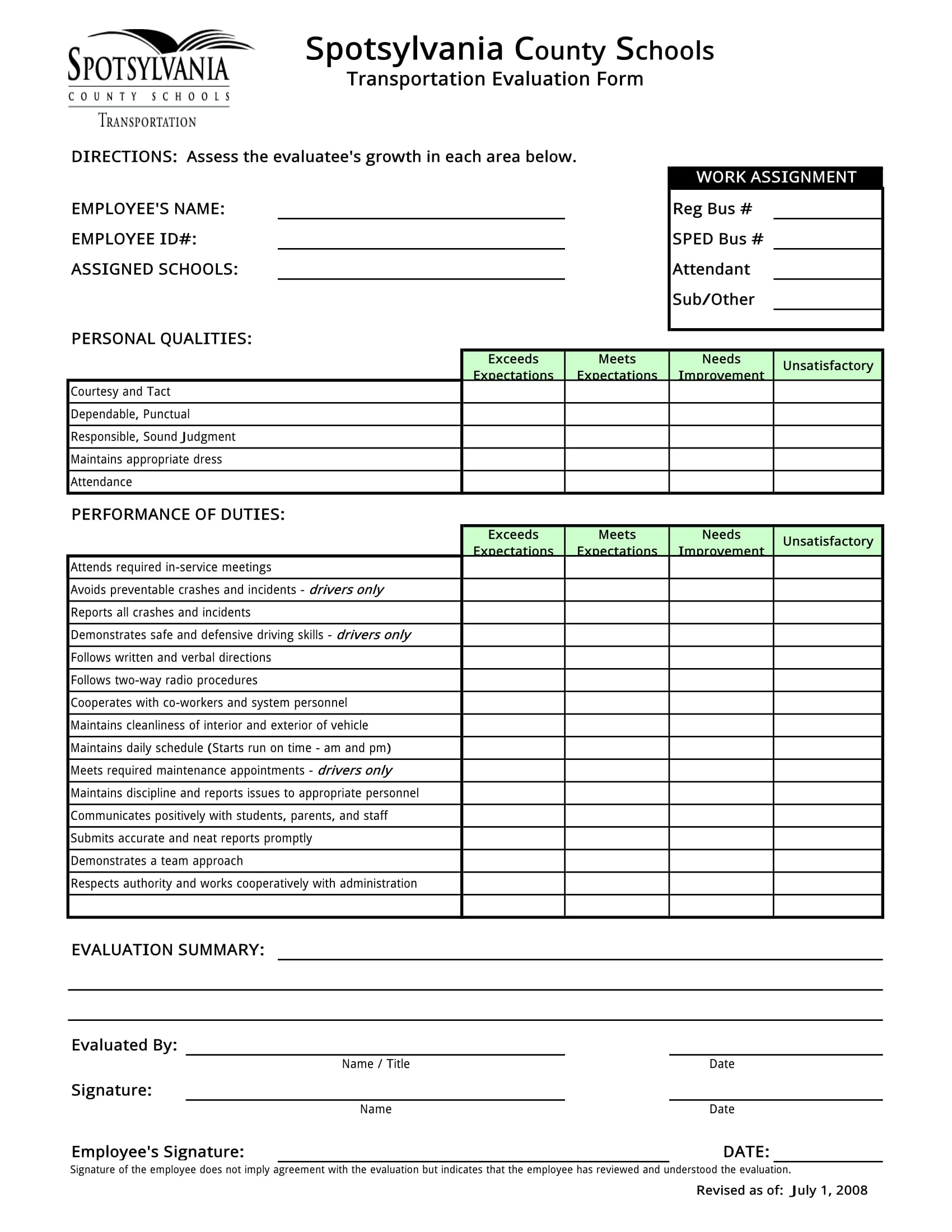A vehicle evaluation form is a document that will focus on the scores and ratings that the assessor gave for the vehicle’s appearance, structure, functionality, and safety. Without the evaluation form, the users of a particular vehicle may commit themselves to an accident and even in an unknown crime that was not acknowledged by a licensed assessor.
Although it is necessary that a legal form individual who is knowledgeable about assessing and evaluating vehicles should be the one who will conduct the evaluation, owners and vehicle purchasers may also do the evaluation to secure that their needs are catered such as their standards for the type of vehicle that they will buy, as well as in determining the reasons why they must sell the vehicle.
Blank Vehicle Evaluation Form
Motor Vehicle Evaluation Form
Motor Vehicle Damage Evaluation Form
Used Car Checklist Evaluation
Vehicle Assessment Evaluation Form
What’s in a Vehicle Evaluation Form?
Vehicle evaluation forms can be in a full-colored document, black-and-white, physical paperwork, and even in a format that can be viewed across the globe through the Internet. Although the formats vary, a vehicle evaluation form must be composed of the following significant sections:
Date of the Evaluation
The reason for indicating the date of the vehicle’s evaluation is to assure that the job assessments and results of the procedure are up to date. Most companies and organizations that demand the presentation of the evaluation form will require the vehicle owner to undergo a recent evaluation wherein the assessor or the appraiser is a licensed individual who works under the company itself. Along with the date should be the evaluation number and the name of the individual who conducted the evaluation.
Details of the Vehicle
The vehicle’s make, model, and mileage rate are found in this section with the vehicle’s identification verification number that is registered under the state’s office or department of vehicles. Some buyers aim to secure that the details are exactly similar to the records of the state, which is why sellers should prepare the sample legal forms and documents that can prove the vehicle’s identity and a clean slate of ownership. Engine size and the specific year that the vehicle was made and purchased may also be included to properly determine the vehicle’s age.
Specs and Options
Different vehicles have different specs and options depending on the manufacturer and the type of vehicle. With this section, the seller or the vehicle owner should indicate whether the vehicle has a basic, mid, or full options, as well as the specified specs it contains. An indication whether the paint on the vehicle is the original or if it has been repainted is also an essential detail that needs to be included.
History of the Vehicle
History refers to the previous condition of the vehicle and the incidents that it got involved with his past owners. Similar to a criminal and employment history, a lineup of the vehicle’s years of being involved in an accident whether due to the recklessness of the driver or a machine failure, rather than of a person’s, should be specified on the form. The importance of integrating these pieces of information is to inform the buyer about the possibilities of the incident to reoccur or the probability that the vehicle has been fully fixed before it is being held for a sale in the market. Additionally, the service employment history should also be stated along with the names of the shops where it was painted and fixed.
Remarks
The employee suggestions and feedback of the appraiser or the assessor of the vehicle will be allotted in this area. By reading the remarks, the buyer will be able to grasp all the information that he needs which are not included in the aforementioned sections.
Contact Details of the Parties
The contact information of the buyer, seller, and the owner of the vehicle are important to be stated in the form. This allows all the parties to reach out to one another whenever issues and concerns will arise after the purchase or appraisal.
Vehicle Condition Evaluation Form
Vehicle Driver Performance Evaluation
Vehicle Evaluation Information Form
Vehicle Inspection Evaluation Form
When to Use a Vehicle Evaluation Form
There are numerous ways and instances when a vehicle evaluation form will be a useful document for the people involved in a transaction, and these are stated below:
During an Appraisal
Vehicle and auto appraisals are common especially for purposes of selling a vehicle. When the appraiser will conduct a vehicle evaluation, the current state and an in-depth history of the vehicle will be outlined to aid in determining the actual appraised value of the market. On the other hand, the market’s demand for the type of vehicle and the range of competition in the market are two aspects that will highly affect any material to be appraised.
Evaluating Damage
Most vehicles that had been in an accident can no longer be allowed to be used by their owners due to the fact that it may become a reason for an accident to occur once again. With this, the Department of Vehicles in a state will require the accident statement of the victim who is the owner of the vehicle to undergo a vehicle evaluation for them to secure the safety and welfare of the person.
Maintenance Inspection
Purchasing a vehicle is not the end for the financial struggles of the owner since he needs to commit to himself in sending the vehicle for a maintenance inspection. The people who will manage the inspection will use a specific evaluation assessment form for indicating their observations. The results of the assessments will then be presented to the owner after the inspection.
Test Driving
Vehicle evaluation forms don’t need to be in a formally structured document if it is used for merely checking in a test-drive. With this, a performance evaluation checklist is an effective and concise choice for an individual who wants to assure that he will purchase the right vehicle or car for him. However, the checklist should include all the essentials in a test-drive to meet the purpose of the evaluation.
Trading Used Vehicles
Trade-ins or exchanging used vehicle for another has now become an evident option for those people who aim to experience handling vehicle varieties. Although this may be a fun adventure to go through, individuals who will consider trading their properties should assure that the exchanged vehicle is functional and is accompanied with legal documents such as vehicle registration forms and other paperwork. Along with the paperwork should be an updated evaluation about the vehicle’s condition as well as its mileage reports. The purpose of doing these preventive measures is for safety and to assure that the legalities were met before, during, and after the trade-ins.
Vehicle Maintenance Inspection Form
Vehicle Road Driving Evaluation
Vehicle Test Drive Evaluation Form
Vehicle Trade-In Evaluation Form
Vehicle Transportation Evaluation Form
Tips for Vehicle Evaluation
Evaluating a vehicle does not simply mean that an individual will only have to go for a single look and head out for purchasing the car. This is why an individual must keep the following tips in his mind along with the aforementioned steps of vehicle evaluation:
Honesty is vital
Selling a car or a motorcycle nowadays is not an easy task to both the seller as well as the purchaser due to the ever-growing varieties of brands of vehicle. Nonetheless, both parties should be honest and concise unto one another in order to secure that there will be zero percent of fooling around in a serious business agreement. The actual worth, reason why the car has been up for sale, and the previous owner of the car should be known to the buyer. This is to allow the buyer in dealing or addressing issues that were not informed to him prior to the day of his purchase. Additionally, a disclosure statement may be used by the involved parties to assure that all the details of the car including the legal state of the car will be reported and recorded.
Determine the condition
Broken mirrors, failure to start up immediately, as well as a ripped leather from the car seat should be written on a document or the evaluation to address concerns. Although the seller will have to speak out to the buyer about the vehicle, it is also significant that the buyer will state his observation feedback that relate to the functionality of the vehicle rather than the mere outside appearance of it. The condition of the vehicle is also essential for granting the right valuation amount in events that the vehicle will be held as a collateral for a loan.
Acknowledge legalities
Car bill of sale documents and vehicle purchase agreements should be presented to the buyer before he will purchase the vehicle. The reason for the representation of documents is to assure the buyer that the vehicle is legally for sale, rent, or have undergone a proper appraisal by a licensed vehicle appraiser. The documents will serve as a tool for the buyer to provide trust to the other party. For instance that the buyer has witnessed that the presented documents showed falsified data, he can promptly head to the authority and report the incident to secure that he will not get involved in a criminal case.
With all the stated tips, an individual who will do an evaluation should keep in mind that he needs to allocate time before deciding on an action. The allotted time will allow the individual to review his evaluations and assessment forms, determine if his scored evaluation have met his standards, and come up with the appropriate decision of whether proceeding to purchase or decline the seller’s offers.
Related Posts
-
Internship Evaluation Form
-
Food Sensory Evaluation Form
-
Candidate Evaluation Form
-
Call Monitoring Evaluation Form
-
Chef Evaluation Form
-
Customer Service Evaluation Form
-
Mentee Evaluation Form
-
Speaker Evaluation Form
-
FREE 14+ Trainee Evaluation Forms in MS Word | PDF
-
Resume Evaluation Form
-
FREE 14+ Retreat Evaluation Forms in PDF
-
Debate Evaluation Form
-
FREE 14+ Book Evaluation Forms in PDF | MS Word
-
Why an Employer Performs a Job Evaluation [ Significance, Steps ]
-
FREE 7+ Sample Child Care Evaluation Forms in MS Word | PDF
